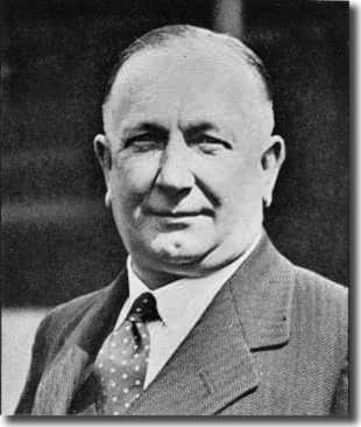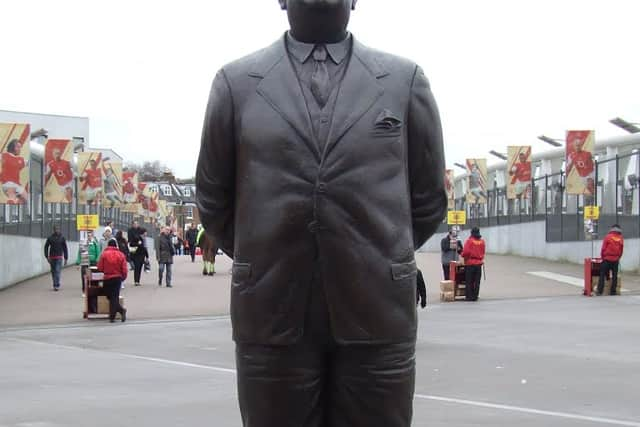A look back at the life of Herbert Chapman - The Godfather of the Game


Happy birthday, Herbert Chapman.
The Millers’ trip to Huddersfield Town earlier this season sparked memories of Herbert, who took the Terriers to the old First Division title in 1924 and 1925, switched to Highbury and then turned the Gunners from also-rans to league champions in 1933.
In reality, though, he could rightly be said to have claimed double title hat-tricks with both clubs, because Huddersfield were crowned champions for a third successive time in 1926 and, after his untimely death, Arsenal were top of the pile in 1934 and 35—all effectively being Chapman's teams playing under Chapman's guidelines.
Advertisement
Hide AdAdvertisement
Hide AdA strict disciplinarian, Chapman, born in 1879, was one of seven children born in a terraced row of pit houses at Park Terrace in Kiveton.
After his Methodist upbringing – Chapman would never consider playing football on a Sunday – he went on to combine a religious fervour with shrewd tactician's brain, which proved the key elements in his astonishing successes.
Today, alongside @ntfc, @htafcdotcom and @Arsenal, we celebrate the 140th birthday of the great Herbert Chapman
Give us a follow to learn how a boy from our little village became one of the most successful and influential figures in football history
Happy birthday Herbert! pic.twitter.com/RKFThzMLBz
— Kiveton Park FC (@KivetonParkFC) January 19, 2018In those days of the last century it was said that football was one of the few routes out of the pit and it was one which a young Chapman was determined to pursue.
One day, as a 17-year-old, he strode out from his shift vowing that there must be something better – and it was the start of a career in football that would eventually earn him the title of Godfather of the Game.
Advertisement
Hide AdAdvertisement
Hide AdHe eventually became manager of Huddersfield and took the Leeds Road side to the top, before Arsenal moved in to take him to Highbury.
Prior to Chapman's arrival in 1925, Arsenal's best finishing position was ninth in 1921 and reaching the FA Cup quarter finals in 1922, when they lost to Preston.
Chapman's first game as manager was on August 29, 1925, against Spurs at Highbury when Arsenal lost 1-0.
After a poor start to his first season – the 1-0 defeat at home to Tottenham and a 7-0 defeat at Newcastle in October – Chapman was convinced to adopt the 3-4-3 formation, later associated with the great Arsenal teams.


Herbert Chapman statue
Advertisement
Hide AdAdvertisement
Hide AdThe result was that Chapman's first season ended with Arsenal gaining a respectable, and at that time a club record, 52 points, finishing second in the league.
Chapman, responsible incidentally for putting the now famous white sleeves on Arsenal's red shirts, had been quoted as saying that it would take five years to win a trophy. He was right.
Arsenal finished a mediocre 11th, 10th, 9th and 14th respectively the next four seasons. Despite their league performances, the 1926-27 season saw Arsenal play their first FA Cup Final, although they were beaten by Cardiff City.
The 1929-30 season saw Arsenal reach the Cup final for a second time and this time they took home the trophy for the first time with a 2-0 win, ironically against Huddersfield Town.
Advertisement
Hide AdAdvertisement
Hide AdIt all started to come right and Chapman's first Highbury title came in 1933 – but he contracted pneumonia and died on February 6th, 1934, aged 55.
At his funeral a crowd of 2,000 paid tribute by lining the streets, kept on the pavement by a police cordon, as Chapman's cortege, draped in red and white, passed by.
🗓 The great Herbert Chapman was born on this day in 1878 pic.twitter.com/aJOFljiXZX
— Arsenal FC (@Arsenal) January 19, 2018Eight hundred dignitaries attended the service.
Chapman's legacy was to continue until the present day, as Arsenal became firmly established as one of the country's top clubs.
They won the championship in 1934 and '35 and then finished second before claiming a fourth crown in five years in 1937.
And it was all thanks to the miner's lad from Kiveton.